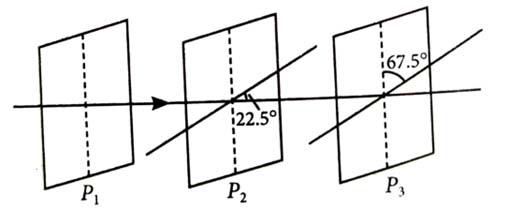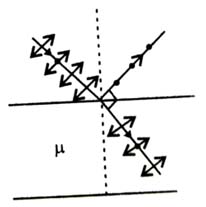Topic Question Set
Q 1
:
The intensity of transmitted light when a polaroid sheet, placed between two crossed polaroids at from the polarization axis of one of the polaroid, is ( is the intensity of polarised light after passing through the first polaroid) [2025]
(1)

According to the Malus law,
or
Q 2
:
An unpolarized light beam travelling in air is incident on a medium of refractive index 1.73 at Brewster’s angle. Then [2025]
both reflected and transmitted light are perfectly polarized with angles of reflection and refraction close to 60° and 30°, respectively.
transmitted light is completely polarized with angle of refraction close to 30°
reflected light is completely polarized and the angle of reflection is close to 60°
reflected light is partially polarized and the angle of reflection is close to 30°
(3)
Brewster's angle,
where is the refractive index of air and is the refractive index of the given medium, .
By law of reflection,
When an unpolarised light is incident on a medium of reflective index 1.73 at Brewster’s angle, then reflected light is completely polarised.
Q 3
:
A beam of unpolarised light of intensity is passed through a polaroid A, then through another polaroid B, oriented at and finally through another polaroid C, oriented at relative to B as shown. The intensity of emergent light is [2024]


(1)
Unpolarised light when passed through a polaroid is reduced to half of its initial value.
So,
Using Malus law for polaroid B
At polaroid C,
Q 4
:
An unpolarised light beam strikes a glass surface at Brewster’s angle. Then [2024]
the reflected light will be partially polarised.
the refracted light will be completely polarised.
both the reflected and refracted light will be completely polarised.
the reflected light will be completely polarised but the refracted light will be partially polarised.
(4)
According to Brewster’s law, when an unpolarised light beam strikes a glass surface at Brewster’s angle, then the reflected light is completely polarised and the refracted light will be partially polarised.
Q 5
:
The Brewster's angle for an interface should be [2020]
(3)
We know,
As
Q 6
:
Unpolarised light is incident from air on a plane surface of a material of refractive index . At a particular angle of incidence , it is found that the reflected and refracted rays are perpendicular to each other. Which of the following options is correct for this situation? [2018]
Reflected light is polarised with its electric vector parallel to the plane of incidence.
Reflected light is polarised with its electric vector perpendicular to the plane of incidence.
-
-
(2)

When reflected light and refracted light are perpendicular, reflected light is polarised with electric field vector perpendicular to the plane of incidence.
Also,
Q 7
:
Two polaroids and are placed with their axis perpendicular to each other. Unpolarised light is incident on . A third polaroid is kept in between and such that its axis makes an angle with that of . The intensity of transmitted light through is [2017]
(2)
The intensity of transmitted light through ,
The intensity of transmitted light through
Angle between polaroids and

